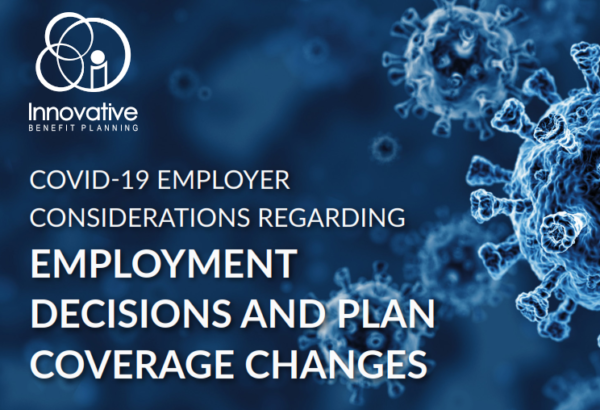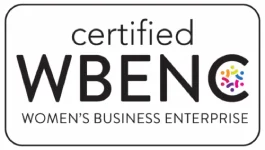COVID-19 Employer Considerations Regarding Employment Decisions and Plan Coverage Changes

Due to the recent national health crisis in our country, many employers are considering the best way to handle a temporary economic turndown to best position themselves for recovery once the pandemic ceases and businesses can begin to return to some sense of normalcy. In addition, many employers are also navigating the benefit coverage changes being made by their insurance carrier(s) or by state and/or federal mandates which may include cost considerations, plan document revisions and employee notifications. Below are some explanations regarding various workplace employment options and health plan considerations.
Employer/Employee Relationship
One of the decisions employers are faced with is how to handle their workforce. Employers and insurance companies are using many terms to describe employer/employee relationships such as reduction in hours, furlough, temporary layoff, and permanent layoff. Many employers desire to keep employee benefits intact during this period. It is important to understand the differences and how your decision can affect various health and welfare benefits offered by your company.
Furlough/Temporary Layoff
A furlough does not have a precise legal definition but generally refers to a mandatory period of time off work without pay initiated by the employer and intended to be for a temporary or limited duration. Sometimes the term “temporary layoff” is used. A furlough is similar to an unpaid leave of absence. Generally, the employee remains on payroll and may remain eligible for benefits, including health insurance coverage, while on furlough, with a mutual expectation of reinstatement. Furloughs are typically used in periods of significant economic downturn and during seasonal business cycles. Specific to health insurance coverage, the Affordable Care Act (ACA) requires employees who are in their stability period (designated by the employer) remain on their health benefits until the end of such stability period is over or termination of employment. Many insurance carriers who provide life insurance, short-term disability, long-term disability and other ancillary products have also relaxed their rules regarding actively-at-work provisions to extend coverage to employees impacted by reduction in hours, furloughs or temporary layoff.
An employer may furlough employees rather than permanently laying off and terminating employees because the business downturn is expected to be temporary. A furlough helps an employer reduce its compensation costs and potentially also hiring costs when it brings furloughed employees back to work instead of having to hire and train replacements.
Permanent Layoff
A permanent layoff generally refers to when an employer terminates an employee’s employment without any right to be recalled and reinstated if business conditions improve. Unlike a furlough, benefits typically are terminated when an employee is laid off, including health benefits. Of course, health benefits and other coverages such as but not limited to health, dental, vision, and various savings accounts must be offered to an employee to allow for continuation of coverage under COBRA.
Next Steps
Whether you offer self-funded or fully-insured health and welfare plans, it is recommended that you work with your insurance carrier partners to understand their position during this pandemic such as important time frames and required notifications to ensure coverage for your employees. An employer should also consider the stimulus packages being provided to large and small employers under the CARES Act before making any decisions. However, if you are in employer that has already needed to make tough decisions for your company, some of the stimulus packages may provide relief on a retro basis. For more information on the CARES Act and how it may help your company please visit our COVID-19 Resource Center.
Employee Health Plan Coverage Changes
There have been many changes to health plan coverage provisions in response to the outbreak of COVID-19. Depending on whether you provide a fully insured or self-funded health plan to your employees provide employers with different considerations.
Fully Insured
All fully insured health plans must comply with all state and federal mandated requirements. All fully insured carriers must cover 100% of the COVID-19 test and any related services provided to diagnosis COVID-19. In other words, member cost share is waived for these services which may include services and supplies provided to members to implement, administer, and/or evaluate the need for testing related to COVID-19 in office, telehealth, urgent care, or emergency room. The cost for this test is estimated to range from $50 to $125, not including other services that may be required to obtain the test.
Certain fully insured carriers are beginning to cover the treatment of COVID-19 by waving any member cost share. The average cost of a mild inpatient hospital stay is $35,000 but can be as high as $70,000 for more severe cases. In addition, telemedicine and telehealth services offered by fully insured carriers are being covered at 100% with no member cost share to help prevent the spread of the virus. This includes telemedicine services offered by a third-party vendor such as Teladoc or MD Live and includes telehealth visits offered by participating insurance carrier network providers.
Self-Funded
Plan sponsors with a self-funded health plan must comply with federal mandates and are subject to ERISA. Like fully insured carriers plan sponsors must also waive member cost share for the COVID-19 test and any related services in connection with the diagnosis of COVID-19. At this point in time, plan sponsors have the choice to waive member cost share for the treatment of COVID-19 and telehealth visits for non-related COVID-19 diagnosis. If a plan sponsor decides to waive the cost share for these types of services, it is important to communicate these changes with your stop loss carrier for approval. Understanding the rapidly changing environment, many stop loss carriers have relaxed their rules regarding time frames for notifications of any plan document changes and have allowed up to 60 to 90 days to submit after the plan changes have been made.
Pre-Tax Savings and Reimbursement Plans
Plan sponsors with a self-funded health plan must comply with federal mandates and are subject to ERISA. Like fully insured carriers plan sponsors must also waive member cost share for the COVID-19 test and any related services in connection with the diagnosis of COVID-19. At this point in time, plan sponsors have the choice to waive member cost share for the treatment of COVID-19 and telehealth visits for non-related COVID-19 diagnosis. If a plan sponsor decides to waive the cost share for these types of services, it is important to communicate these changes with your stop loss carrier for approval. Understanding the rapidly changing environment, many stop loss carriers have relaxed their rules regarding time frames for notifications of any plan document changes and have allowed up to 60 to 90 days to submit after the plan changes have been made.
Dental/Life/Disability Carriers
In addition to the above, many dental, life and disability carriers have also relaxed their rules regarding actively at work status due to the current climate.
While there have been many changes over the last three weeks, we expect more fluctuation will be present in our marketplace in the very near future. The impact on US companies will provide a continued response from insurance carriers and plan sponsors alike.
Any questions or concerns regarding this or any other workforce issues during the COVID-19 pandemic, please contact the Innovative team or visit our COVID-19 Employer Resource Center for daily updates.
For a downloadable PDF, click here.
Categories
Archive







